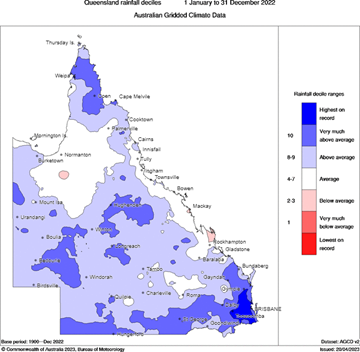QLD heavy steer supply expected to increase
03 May 2023
Key points:
- Excellent seasonal conditions in Queensland’s key grassfed bullock regions are promoting positive growth rates and an outlook of strong supply for the remainder of 2023.
- Evidence of improving processor capacity can be seen in weekly kill numbers, which are higher in Queensland by 30% or 201,000 head year-to-date compared to 2022.
- Grassfed beef production is expected to increase when the Australian Bureau of Statistics (ABS) releases March quarter data in a fortnight.
MLA’s Market Information team has analysed existing yarding volumes of grown steer supply in Queensland compared with 2022. Excellent seasonal conditions point towards a strong uptick in grassfed bullock supply in the second half of 2023.
2022 wrap: Queensland rainfall and tight supply
In 2022, supply of grown steers in Queensland fell 17% or 9,000 head, while in 2023, volumes in year-to-date terms are already 24% or 3,500 head lower.
Figure 1 highlights the strong rainfall that large parts of western Queensland’s channel country and central Queensland experienced in 2022. The Bureau of Meteorology (BOM) records indicate >80% of the state’s 2022 rainfall was above the yearly average, dating back to 1900.

Figure 1. Queensland 2022 Rainfall deciles
Strong rainfall in 2022 and Queensland’s subsequent decline in heavy steer supply in 2023 are both factors pointing towards strong supply of grassfed bullocks hitting the market in the second half of this year.
Slaughter to be supported by grassfed supply
As a result of the impending increase in grassfed bullock supply between now and the end of the year, slaughter volumes will be supported by higher supplies of grassfed stock. The key determinant of overall performance will be processors’ ability to maintain and increase plant throughput and efficiency as higher supplies of grassfed stock are sold.
So far in 2023, evidence of improved processor capacity can be seen in the weekly kill numbers, as shown in the weekly NLRS Slaughter report. Queensland weekly cattle slaughter is already operating 30% or 201,000 head higher in year-to-date terms compared with 2022.
As the cattle cycle matures and Queensland continues its herd rebuild, producers’ flexibility to offload finished stock will ensure steady supplies through the state’s key grassfed bullock regions.
Grassfed beef production to rise
Due to higher supplies of processed grassfed stock this year, it is expected that upcoming ABS data will indicate a strong uptick in grassfed beef production in the March quarter (in percentage terms).
As Australia has long been considered a grassfed-dominated beef production system, returns to a higher percentage of grassfed production as the cattle cycle matures is not unexpected.
Meanwhile, grainfed production is also expected to remain historically high in percentage terms but slightly decline from its record 2022 results, reflecting the structural transition the industry is making to a larger percentage of grainfed beef production.


